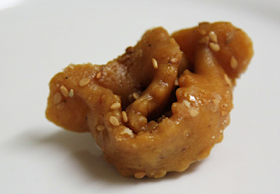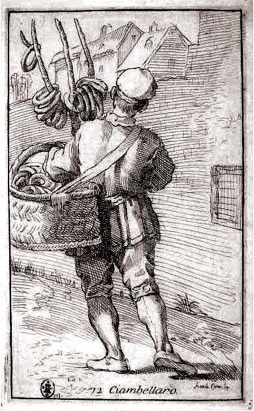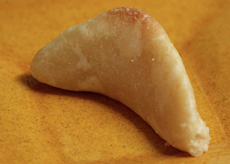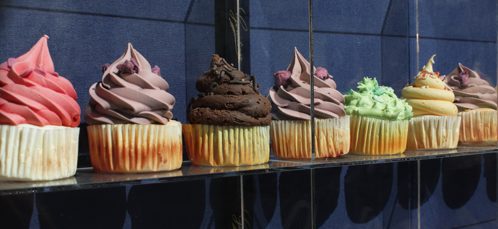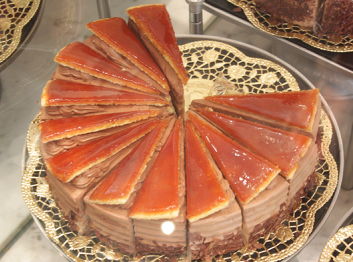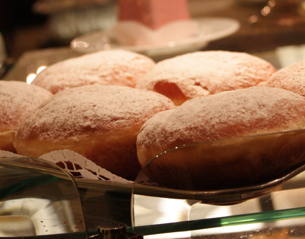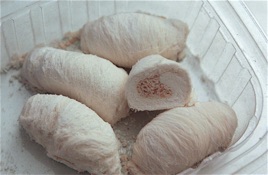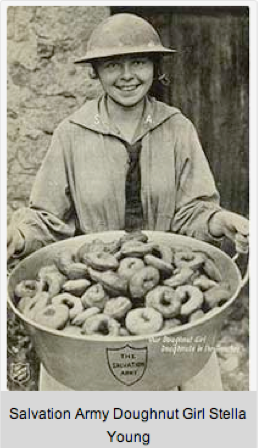See
dulce de leche (below).
A Sicilian speciality, consisting of a fried cylinder filled with a sweet-ricotta cream. The dessert probably descends from an medieval Arab recipe.
c
annoli
chebbakia, mkharka Morocco
A sesame encrusted flower-shaped fritter traditional for Ramadan. The pastry is generously flavored with saffron and other spices and coated in honey and sesame seeds after frying. See
recipe.
A jelly of kudzu starch wrapped in bamboo grass.
ciambella, giambella Italy
A dense, crusty custard (or baked pancake) studded with fresh black cherries (classically unpitted) traditional to Limousin.
cookie United States, biscuit United Kingdom, France, biscotto Italy
Just about every dessert-loving culture has some sort of small cakes that are eaten by hand. Sweet cookies called biscotti existed in Italy at least as early as the 16th century and various small cakes were popular throughout pre-Revolutionary France as a snack to go with newly popular beverages like hot chocolate, coffee and tea. In the eighteen-hundreds the British pioneered techniques of mass producing “biscuits.” Manufacturers in France, Germany and the United States soon followed suit. The American term “cookie” comes from the Dutch koekje, or “little cake” which is just what the early Dutch colonial treats resembled. In the United States, most cookies resembled rolled sugar cookies until the late 1800s. Drop cookies came into their own around the turn of the twentieth century eventually morphing into such American classics as oatmeal cookies, peanut butter cookies and chocolate chip cookies. (For more on drop cookies see my
blog.)
cornes de gazelle Morocco
Crescent-shaped cookies filled with ground almonds and scented with orange flower water and other flavorings. See
recipe.
crème brûlée France, burnt cream, UK
A rich custard is topped with a thin layer of sugar that is caramelized just before serving, creating a hard crisp layer that contrasts with the creamy custard beneath. There is some controversy about who first came up with the idea; some writers posit an English origin (I’m skeptical) or an Iberian birthplace (which seems more likely given the Portuguese and Spanish obsession with custard). The first recipe that we know of, however, is in a late seventeenth French cookbook written by François Massialot. (See
Le Cuisinier royal et bourgeois, p. 219). If cookbooks are any indication of popularity, the following century saw quite a vogue for crème brûlée in both France and Englan--where it was known under its literal translation: “burnt cream.” The 1980s saw a huge crème brûlée renaissance in fancy restaurants in the United States and elsewhere.
Small frosted cakes usually baked in a muffin tin. The “cup” in the name originally referred to the measurement of the ingredients that went into the batter—a cup of butter, two cups sugar, three cups flour, and so on. While in the United States, the current cupcake craze can probably be attributed to the refusal of baby boomers and their offspring to grow up, internationally the culprit is more likely worldwide reruns of “Sex and the City.”
b
A sweet, egg-enriched bread/cake typical of Easter in Calabria. It takes the form of a round braided circle (though other shapes--hearts, birds, fish--are also common) in which one or more eggs is typically embedded.
A soft round pillow of
mochi (rice flour paste) filled with sweetened red or white bean paste.
Ichigo daifuku is a whole strawberry wrapped in
mochi.
daifuku
Small custard tarts popular in Cantonese bakeries (
tat comes from the English word “tart”). Presumably these were originally adopted and adapted from the similar Portuguese
pastéis de nata most likely by way of Macao.
Dampfnudel Austria/Bavaria
Large steamed dumplings today typically served with a custard sauce.
Da
The doberge cake is a New Orleans specialty apparently created by Beulah Ledner in the 1930s. The cake is based on the Dobostorte–thus the name–but is made by layering American-style yellow cake with either chocolate or lemon pudding, resulting in a cake than can easily top 6 inches (15 cm) in height. The outside it typically frosted with buttercream. For more on its invention see
Carolyn Kolb, “Sweet Story,” New Orleans Magazine (June 2008).
Dobostorte Austria, Hungary
Dobostorte
is made by layering five or more ultra-thin sheets of sponge cake, with chocolate buttercream, the whole finished with a mirror-like finish of caramel. The cake is named after Lajos Dobos who created his multistoried extravaganza in the 1880s, presumably basing his cake on the somewhat earlier gâteau moka.
doce de leite da sogra Brazil
Two small wheat flour pancakes sandwich a filling of red bean paste.
dorayakidoughnuts United States, beignets France, Louisiana (US), Krapfen Krapfel, Austria/Germany koblihy Czech Republic, paczki Poland, frittele, bignè Italy
Doughnuts are probably as old as frying. The ancient Greeks had their doughnuts, as did the Indians and
medieval Arabs. Spanish speakers in both the Old World and the New eat several kinds of
churros. In Central Europe, filled doughnuts are popular. They have long been associated with Carnival due to the large amount of lard (forbidden during Lent) that used to be needed to fry them properly. Early German recipes for Krapfen date to at least the Middle Ages. Loosely speaking there are three ways to make a ball of fried dough. One of the oldest (there is a recipe for this in the ancient Roman cookbook attributed to Apicius) is to mix hot water and flour and occasionally eggs resulting in a sort of cream-puff dough. Spanish churros and Italian
zeppole are made this way. More widespread is the use of a yeast dough. In North America doughnuts are also often made with a chemically leavened dough. This is the typical cider doughnut of New England as
well as many of the varieties on offer at Dunkin’ Donuts. In America there is some evidence that yeast-leavened doughnuts are descendants of Dutch settler’s
oliekoecken (“oil cakes”) at least in New York State. Whether the same ancestor can be credited for the doughnuts of New England is somewhat more dubious. The first mention of the typical doughnut shape dates to Civil War though it may have been around for decades before that. Today, both yeast-leavened and baking-powder- or soda-leavened doughnuts are popular across the United States, some filled with jelly or custard, others in the now-traditional life-saver shape.
A candy more than a dessert, this is made of super-thin threads of sugar (thus the dragon’s “beard” or “hair”) wrapped around a filling of peanuts and coconut. Think very dense and chewy cotton candy with a crunchy center. See the
recipe on Food.com.
dulce de leche Latin America, doce de leite Brazil
Dulce de leche is made by cooking down sweetened milk resulting in a thick syrupy consistency with a rich caramelized flavor. It is popular throughout Latin America where it is used as a spread, sauce or flavoring for other desserts. While most dulce de leche is made of cow’s milk, the Mexican variation, called
cajeta, is more commonly made of goat’s milk.



















